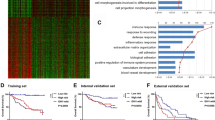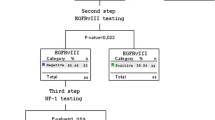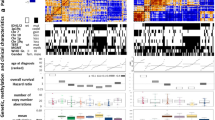Abstract
Cerebral gliomas of World Health Organization (WHO) grade II and III represent a major challenge in terms of histological classification and clinical management. Here, we asked whether large-scale genomic and transcriptomic profiling improves the definition of prognostically distinct entities. We performed microarray-based genome- and transcriptome-wide analyses of primary tumor samples from a prospective German Glioma Network cohort of 137 patients with cerebral gliomas, including 61 WHO grade II and 76 WHO grade III tumors. Integrative bioinformatic analyses were employed to define molecular subgroups, which were then related to histology, molecular biomarkers, including isocitrate dehydrogenase 1 or 2 (IDH1/2) mutation, 1p/19q co-deletion and telomerase reverse transcriptase (TERT) promoter mutations, and patient outcome. Genomic profiling identified five distinct glioma groups, including three IDH1/2 mutant and two IDH1/2 wild-type groups. Expression profiling revealed evidence for eight transcriptionally different groups (five IDH1/2 mutant, three IDH1/2 wild type), which were only partially linked to the genomic groups. Correlation of DNA-based molecular stratification with clinical outcome allowed to define three major prognostic groups with characteristic genomic aberrations. The best prognosis was found in patients with IDH1/2 mutant and 1p/19q co-deleted tumors. Patients with IDH1/2 wild-type gliomas and glioblastoma-like genomic alterations, including gain on chromosome arm 7q (+7q), loss on chromosome arm 10q (−10q), TERT promoter mutation and oncogene amplification, displayed the worst outcome. Intermediate survival was seen in patients with IDH1/2 mutant, but 1p/19q intact, mostly astrocytic gliomas, and in patients with IDH1/2 wild-type gliomas lacking the +7q/−10q genotype and TERT promoter mutation. This molecular subgrouping stratified patients into prognostically distinct groups better than histological classification. Addition of gene expression data to this genomic classifier did not further improve prognostic stratification. In summary, DNA-based molecular profiling of WHO grade II and III gliomas distinguishes biologically distinct tumor groups and provides prognostically relevant information beyond histological classification as well as IDH1/2 mutation and 1p/19q co-deletion status.





Similar content being viewed by others
Abbreviations
- AII:
-
Diffuse astrocytoma WHO grade II
- AAIII:
-
Anaplastic astrocytoma WHO grade III
- AOIII:
-
Anaplastic oligodendroglioma WHO grade III
- AOAIII:
-
Anaplastic oligoastrocytoma WHO grade III
- ATRX:
-
ATP-dependent X-linked helicase
- BRAF:
-
v-raf murine sarcoma viral oncogene homolog B1
- CDK:
-
Cyclin-dependent kinase
- CGH:
-
Comparative genomic hybridization
- CIC:
-
Drosophila homolog of capicua
- EGFR:
-
Epidermal growth factor receptor
- GB IV:
-
Glioblastoma WHO grade IV
- gCIMP:
-
Glioma CpG island methylator phenotype
- GGN:
-
German Glioma Network
- GO:
-
Gene ontology
- IDH:
-
Isocitrate dehydrogenase
- KPS:
-
Karnofsky performance score
- MAPK:
-
Mitogen-activated protein kinase
- MDM:
-
Murine double minute
- MGMT:
-
O6-methylguanine DNA methyltransferase
- OII:
-
Oligodendroglioma WHO grade II
- OAII:
-
Oligoastrocytoma WHO grade II
- OS:
-
Overall survival
- PDGFRA:
-
Platelet-derived growth factor receptor-α
- PFS:
-
Progression-free survival
- PTEN:
-
Phosphatase and tensin homolog on chromosome 10
- SOM:
-
Self-organizing map
- TERT:
-
Telomerase reverse transcriptase
- TMZ:
-
Temozolomide
- TP53:
-
Tumor protein p53
- WHO:
-
World Health Organization
References
Bourne TD, Schiff D (2010) Update on molecular findings, management and outcome in low-grade gliomas. Nat Rev Neurol 6:695–701
Cairncross G, Berkey B, Shaw E, Jenkins R, Scheithauer B, Brachman D et al (2006) Phase III trial of chemotherapy plus radiotherapy compared with radiotherapy alone for pure and mixed anaplastic oligodendroglioma: Intergroup Radiation Therapy Oncology Group Trial 9402. J Clin Oncol 24:2707–2714
Cairncross G, Wang M, Shaw E, Jenkins R, Brachman D, Buckner J et al (2013) Phase III trial of chemoradiotherapy for anaplastic oligodendroglioma: long-term results of RTOG 9402. J Clin Oncol 31:337–343
Cairncross JG, Wang M, Jenkins RB, Shaw EG, Giannini C, Brachman DG et al (2014) Benefit from procarbazine, lomustine, and vincristine in oligodendroglial tumors is associated with mutation of IDH. J Clin Oncol 32:783–790
Cooper LA, Gutman DA, Long Q, Johnson BA, Cholleti SR, Kurc T et al (2010) The proneural molecular signature is enriched in oligodendrogliomas and predicts improved survival among diffuse gliomas. PLoS ONE 5:e12548
Ducray F, Criniere E, Idbaih A, Mokhtari K, Marie Y, Paris S et al (2009) Alpha-Internexin expression identifies 1p19q codeleted gliomas. Neurology 72:156–161
Ducray F, Idbaih A, de Reynies A, Bieche I, Thillet J, Mokhtari K et al (2008) Anaplastic oligodendrogliomas with 1p19q codeletion have a proneural gene expression profile. Mol Cancer 7:41
Felsberg J, Rapp M, Loeser S, Fimmers R, Stummer W, Goeppert M et al (2009) Prognostic significance of molecular markers and extent of resection in primary glioblastoma patients. Clin Cancer Res 15:6683–6693
Felsberg J, Wolter M, Seul H, Friedensdorf B, Goppert M, Sabel MC et al (2010) Rapid and sensitive assessment of the IDH1 and IDH2 mutation status in cerebral gliomas based on DNA pyrosequencing. Acta Neuropathol 119:501–507
Fuller CE, Schmidt RE, Roth KA, Burger PC, Scheithauer BW, Banerjee R et al (2003) Clinical utility of fluorescence in situ hybridization (FISH) in morphologically ambiguous gliomas with hybrid oligodendroglial/astrocytic features. J Neuropathol Exp Neurol 62:1118–1128
Hartmann C, Hentschel B, Wick W, Capper D, Felsberg J, Simon M et al (2010) Patients with IDH1 wild type anaplastic astrocytomas exhibit worse prognosis than IDH1-mutated glioblastomas, and IDH1 mutation status accounts for the unfavorable prognostic effect of higher age: implications for classification of gliomas. Acta Neuropathol 120:707–718
Hartmann C, Meyer J, Balss J, Capper D, Mueller W, Christians A et al (2009) Type and frequency of IDH1 and IDH2 mutations are related to astrocytic and oligodendroglial differentiation and age: a study of 1010 diffuse gliomas. Acta Neuropathol 118:469–474
Hopp L, Wirth H, Fasold M, Binder H (2014) Portraying the expression landscapes of cancer subtypes: A glioblastoma multiforme and prostate cancer case study. SystemsBiomedicine 1:22
Ichimura K, Schmidt EE, Goike HM, Collins VP (1996) Human glioblastomas with no alterations of the CDKN2A (p16INK4A, MTS1) and CDK4 genes have frequent mutations of the retinoblastoma gene. Oncogene 13:1065–1072
Jiao Y, Killela PJ, Reitman ZJ, Rasheed AB, Heaphy CM, de Wilde RF et al (2012) Frequent ATRX, CIC, FUBP1 and IDH1 mutations refine the classification of malignant gliomas. Oncotarget 3:709–722
Jones DT, Hutter B, Jager N, Korshunov A, Kool M, Warnatz HJ et al (2013) Recurrent somatic alterations of FGFR1 and NTRK2 in pilocytic astrocytoma. Nat Genet 45:927–932
Killela PJ, Pirozzi CJ, Healy P, Reitman ZJ, Lipp E, Rasheed BA et al (2014) Mutations in IDH1, IDH2, and in the TERT promoter define clinically distinct subgroups of adult malignant gliomas. Oncotarget 5:1515–1525
Killela PJ, Pirozzi CJ, Reitman ZJ, Jones S, Rasheed BA, Lipp E et al (2014) The genetic landscape of anaplastic astrocytoma. Oncotarget 5:1452–1457
Koelsche C, Sahm F, Capper D, Reuss D, Sturm D, Jones DT et al (2013) Distribution of TERT promoter mutations in pediatric and adult tumors of the nervous system. Acta Neuropathol 126:907–915
Kreuz M, Rosolowski M, Berger H, Schwaenen C, Wessendorf S, Loeffler M et al (2007) Development and implementation of an analysis tool for array-based comparative genomic hybridization. Methods Inf Med 46:608–613
Liu XY, Gerges N, Korshunov A, Sabha N, Khuong-Quang DA, Fontebasso AM et al (2012) Frequent ATRX mutations and loss of expression in adult diffuse astrocytic tumors carrying IDH1/IDH2 and TP53 mutations. Acta Neuropathol 124:615–625
Louis DN, Ohgaki H, Wiestler B, Cavenee WK (2007) WHO classification of tumours of the central nervous system. IARC Press, Lyon
Louis DN, Perry A, Burger P, Ellison DW, Reifenberger G, von Deimling A et al (2014) International society of neuropathology-haarlem consensus guidelines for nervous system tumor classification and grading. Brain Pathol 24:429–435
Mukasa A, Ueki K, Ge X, Ishikawa S, Ide T, Fujimaki T et al (2004) Selective expression of a subset of neuronal genes in oligodendroglioma with chromosome 1p loss. Brain Pathol 14:34–42
Ohgaki H, Kleihues P (2013) The definition of primary and secondary glioblastoma. Clin Cancer Res 19:764–772
Reifenberger G, Weber RG, Riehmer V, Kaulich K, Willscher E, Wirth H et al (2014) Molecular characterization of long-term survivors of glioblastoma using genome- and transcriptome-wide profiling. Int J Cancer 135:1822–1831
Sahm F, Reuss D, Koelsche C, Capper D, Schittenhelm J, Heim S et al (2014) Farewell to oligoastrocytoma: in situ molecular genetics favor classification as either oligodendroglioma or astrocytoma. Acta Neuropathol 128:551–559
Shaw EJ, Haylock B, Husband D, du Plessis D, Sibson DR, Warnke PC et al (2011) Gene expression in oligodendroglial tumors. Cell Oncol (Dordr) 34:355–367
Tews B, Felsberg J, Hartmann C, Kunitz A, Hahn M, Toedt G et al (2006) Identification of novel oligodendroglioma-associated candidate tumor suppressor genes in 1p36 and 19q13 using microarray-based expression profiling. Int J Cancer 119:792–800
van den Bent MJ (2010) Interobserver variation of the histopathological diagnosis in clinical trials on glioma: a clinician’s perspective. Acta Neuropathol 120:297–304
van den Bent MJ, Brandes AA, Taphoorn MJ, Kros JM, Kouwenhoven MC, Delattre JY et al (2013) Adjuvant procarbazine, lomustine, and vincristine chemotherapy in newly diagnosed anaplastic oligodendroglioma: long-term follow-up of EORTC brain tumor group study 26951. J Clin Oncol 31:344–350
van den Bent MJ, Carpentier AF, Brandes AA, Sanson M, Taphoorn MJ, Bernsen HJ et al (2006) Adjuvant procarbazine, lomustine, and vincristine improves progression-free survival but not overall survival in newly diagnosed anaplastic oligodendrogliomas and oligoastrocytomas: a randomized European Organisation for Research and Treatment of Cancer phase III trial. J Clin Oncol 24:2715–2722
Verhaak RG, Hoadley KA, Purdom E, Wang V, Qi Y, Wilkerson MD et al (2010) Integrated genomic analysis identifies clinically relevant subtypes of glioblastoma characterized by abnormalities in PDGFRA, IDH1, EGFR, and NF1. Cancer Cell 17:98–110
Weller M, Felsberg J, Hartmann C, Berger H, Steinbach JP, Schramm J et al (2009) Molecular predictors of progression-free and overall survival in patients with newly diagnosed glioblastoma: a prospective translational study of the German Glioma Network. J Clin Oncol 27:5743–5750
Weller M, Pfister SM, Wick W, Hegi ME, Reifenberger G, Stupp R (2013) Molecular neuro-oncology in clinical practice: a new horizon. Lancet Oncol 14:e370–e379
Wick W, Hartmann C, Engel C, Stoffels M, Felsberg J, Stockhammer F et al (2009) NOA-04 randomized phase III trial of sequential radiochemotherapy of anaplastic glioma with procarbazine, lomustine, and vincristine or temozolomide. J Clin Oncol 27:5874–5880
Wick W, Meisner C, Hentschel B, Platten M, Schilling A, Wiestler B et al (2013) Prognostic or predictive value of MGMT promoter methylation in gliomas depends on IDH1 mutation. Neurology 81:1515–1522
Wiestler B, Capper D, Holland-Letz T, Korshunov A, von Deimling A, Pfister SM et al (2013) ATRX loss refines the classification of anaplastic gliomas and identifies a subgroup of IDH mutant astrocytic tumors with better prognosis. Acta Neuropathol 126:443–451
Wiestler B, Capper D, Hovestadt V, Sill M, Jones DT, Hartmann C et al (2014) Assessing CpG island methylator phenotype, 1p/19q codeletion, and MGMT promoter methylation from epigenome-wide data in the biomarker cohort of the NOA-04 trial. Neuro Oncol 16:1630–1638
Wiestler B, Capper D, Sill M, Jones DT, Hovestadt V, Sturm D et al (2014) Integrated DNA methylation and copy-number profiling identify three clinically and biologically relevant groups of anaplastic glioma. Acta Neuropathol 128:561–571
Wirth H, Loffler M, von Bergen M, Binder H (2011) Expression cartography of human tissues using self organizing maps. BMC Bioinf 12:306
Wirth H, von Bergen M, Binder H (2012) Mining SOM expression portraits: feature selection and integrating concepts of molecular function. BioData Min 5:18
Zielinski B, Gratias S, Toedt G, Mendrzyk F, Stange DE, Radlwimmer B et al (2005) Detection of chromosomal imbalances in retinoblastoma by matrix-based comparative genomic hybridization. Genes Chromosomes Cancer 43:294–301
Acknowledgments
This study was supported by a grant from the German Cancer Aid (Deutsche Krebshilfe, grant no. 70-3163-Wi 3) and by the German Cancer Consortium (DKTK). The authors would like to thank the staff at the clinical centers of the German Glioma Network for their great support as well as our patients and their relatives. We also acknowledge Thorsten Wachtmeister, Center for Biological and Medical Research, Heinrich Heine University Düsseldorf, for his support of the Affymetrix chip hybridizations.
Conflict of interest
MiW has received research grants from Acceleron, Actelion, Bayer, Isarna, Merck Serono, MSD, Piqur and Roche, and honoraria for lectures or advisory boards from Celldex, Isarna, Magforce, Merck Serono, MSD and Roche. GR has received research grants from Roche and Meck as well as honoraria for advisory boards or lectures from Merck Serono, Amgen and Roche. TP has received grants for reference pathology from Antisense Pharma and Merck Serono and honoraria for lectures from Roche. US has received honoraria for lectures or advisory boards from GSK, medac and Roche. TM has received honoraria for lectures from medac and Cyberonics and for advisory boards from Novocure. JCT has received honoraria for lectures or advisory boards from Merck Serono, medac and Roche. CHar has received grants for research and advisory board activities from Apogenix and Oncowave. The other authors declare that they have no conflicts of interest.
Funding
This study was funded by the German Cancer Aid (Grant No. 70-3163-Wi 3).
Access to gene expression data
The gene expression data reported in this study are deposited in the gene expression omnibus (GEO) database at http://www.ncbi.nlm.nih.gov/geo/ under accession number GSE61374 (http://www.ncbi.nlm.nih.gov/geo/query/acc.cgi?token=qhyzsoqmhbibxch&acc=GSE61374).
Author information
Authors and Affiliations
Corresponding author
Additional information
M. Weller and R. G. Weber: share first authorship.
H. Binder and G. Reifenberger: share last authorship.
For the German Glioma Network.
Electronic supplementary material
Below is the link to the electronic supplementary material.
Rights and permissions
About this article
Cite this article
Weller, M., Weber, R.G., Willscher, E. et al. Molecular classification of diffuse cerebral WHO grade II/III gliomas using genome- and transcriptome-wide profiling improves stratification of prognostically distinct patient groups. Acta Neuropathol 129, 679–693 (2015). https://doi.org/10.1007/s00401-015-1409-0
Received:
Revised:
Accepted:
Published:
Issue Date:
DOI: https://doi.org/10.1007/s00401-015-1409-0




